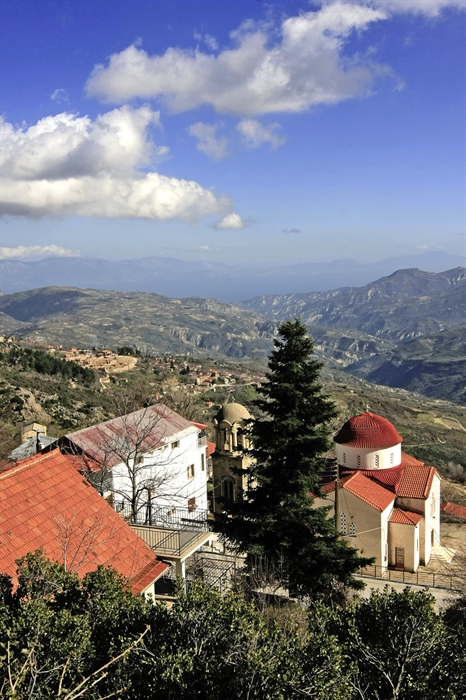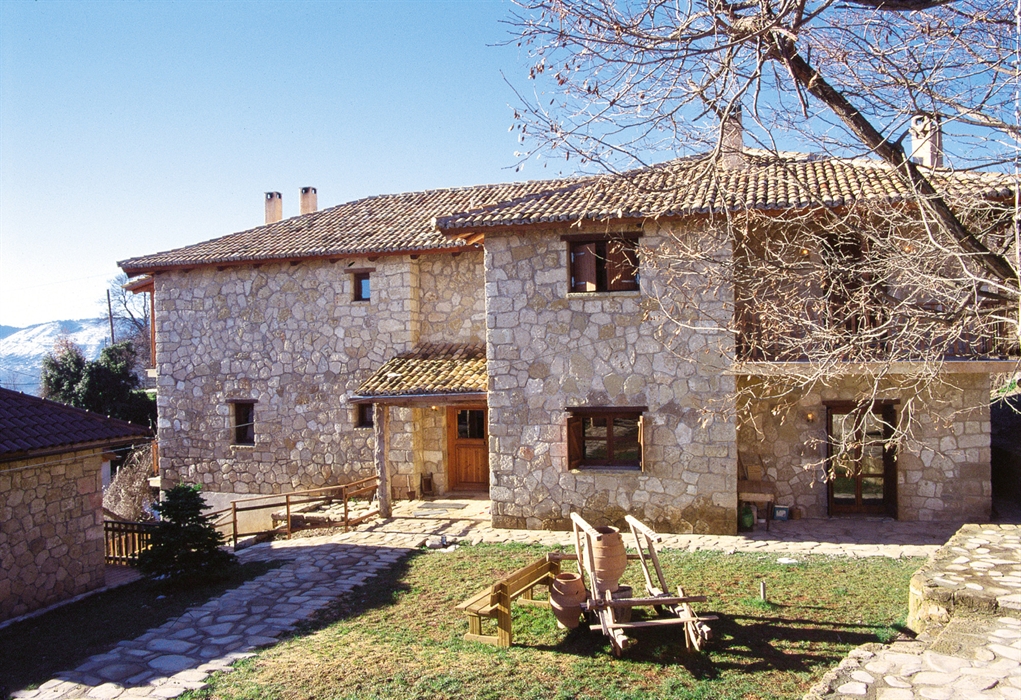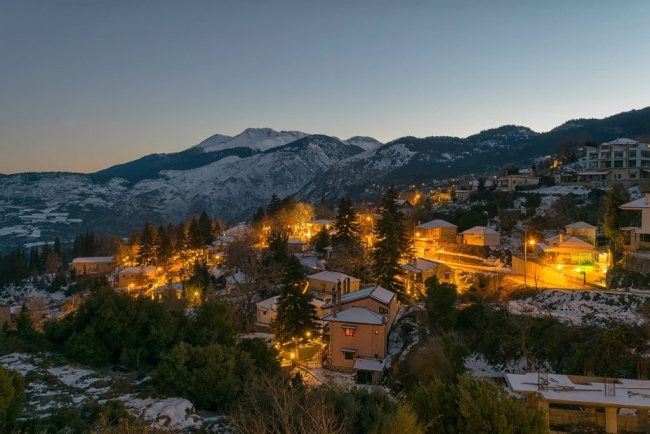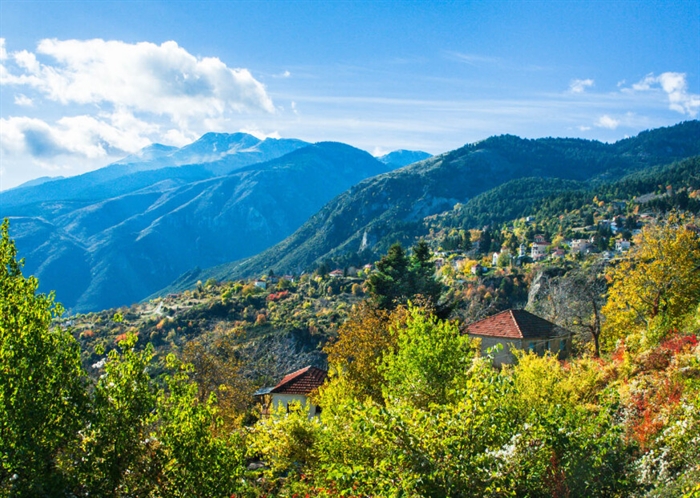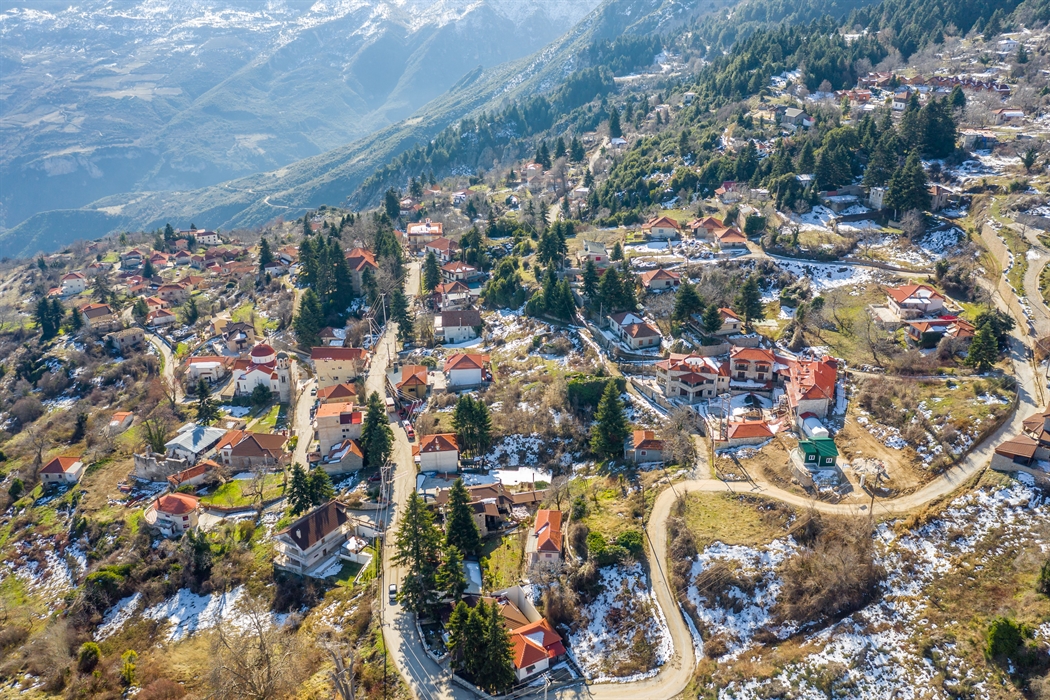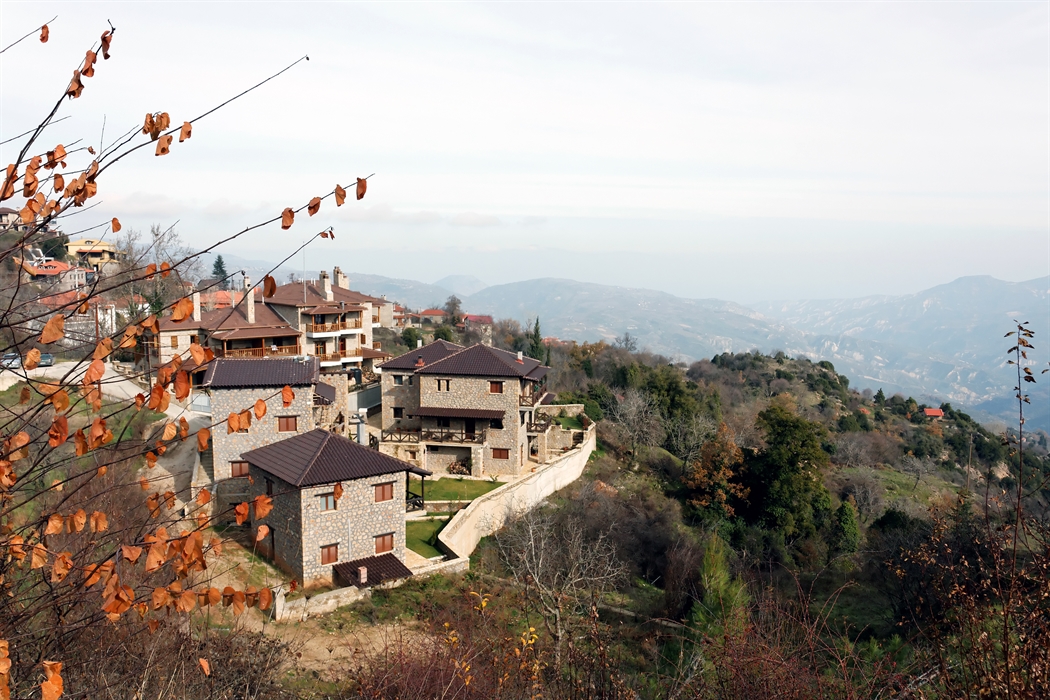Trikala, Corinthia
Trikala, Corinthia is built on the slopes of Mount Ziria, and is the perfect starting point for all your adventures and activities in the mountains of Corinthia. The settlement is divided in three lively neighbourhoods featuring traditional old houses, towers and churches, along with stone-built guest houses and wood chalets, taverns, restaurants, cafes and many more.
Trikala is built on the slopes of Mount Ziria. The Patriarch of Jerusalem, Chrysantho Notaras, wrote in 1716 that the town’s name (tria meaning three and kala meaning good) came from three of the good things you can find here: an abundance of water, healthy air and vines that produce good wine. If we update this idea for more modern visitors, we could add another three good things: nature, outdoor activities and traditional architecture.
The town is built among plane trees and pines, and there are springs and stone drinking fontains, squares, old churches, stone mansions and high towers (some dating back to the 16th century) scattered around all the town’s three districts. And wherever you go, the view of the mountains and the sea is amazing. It is also a great centre for exploring nature and the great outdoors as it is near to the Megali Ziria mountain where you can go walking and climbing.
Trikala is a place for all seasons -but when it snows you might have trouble believing you’re not in Switzerland! Autumn is the time to enjoy the riot of rich warm colours as the trees shed their leaves, and in spring the flowers add their own beauty to the picture.
The village has three distinct districts: Ano (upper) Trikala, Mesaia (Central) Trikala and Kato (Lower) Trikala.
Ano Trikala is 1100m above sea level, so it’s hardly surprising that views from here are outstanding. It’s also shaded by a multitude of poplars, plane trees, cedars and firs, giving the area the feel of a mountain village. During the Turkish occupation, prominent Trikala families-built mansions and high towers in this area, and it gained the nickname “archondomachala”, the mansion neighbourhood. Some of these grand stone-built mansions are still standing. The Dasais house (1806) is impressive, but the most interesting mansion-house is probably the three-story building which belonged to the Notaras family, the most important and influential family in the area. It is a fairly typical example of a fortified home which was built during the Turkish occupation with a combination of stone and wood. It dates back to the first half of the 16th century and in its heyday saw famous guests such as Lord Byron and Greek royalty. In 1962 it was listed as a protected building by the Ministry of the Interior. Next to the Notaras house you’ll see the church dedicated to Saint Gerasimos Notaras, and a little further on you’ll find the church of Agios Nikolaos, the patron saint of the village.
If you’re feeling energetic, the best way to get from Ano Trikala to Mesaia Trikala is via a lovely path called "Ancient Myssaion". The path passes through a beautiful, shady forest and will take you about 45 minutes.
Once you reach Mesaia Trikala, head for the central square. It’s buzzing with life on the weekends as the district caters for tourists and is full of traditional guesthouses, tavernas, cafes etc. There are two notable churches here, the church of the Transfiguration of the Saviour, with the icon of John the Baptist that dates from 1816, and further up in the settlement you’ll find the church of the Dormition of the Virgin Mary (thought to date from 1700). There were also mansion houses in this district of the village, but the families that built them were not as powerful as those in Ano Trikala so the houses are not so impressive. Mesaia Trikala is also the starting point for those who want to go trekking and mountaineering on Megali Ziria and the Flambouritsa valley, and companies that organise horseback expeditions in the area are also based there.
Kato Trikala has a lovely traditional stone-built square with shade from centuries-old plane trees. You’ll find plenty of cafes etc here, and water fountains where you can grab a drink of clear, cool water as you wander round the neighbourhood. The renovated church of Agios Dimitrios is of particular interest and was originally built in 1697.
Trikala is approximately 145 km from Athens.
Food and accommodation
Trikala Corinthia has been a favourite destination for holidays or weekend trips for years (indeed, the first two hotels here were built between 1920-1930). All three areas of the village have plenty of stone-built guest houses and wood chalets, as well as luxury hotels. There’s no shortage of fine tavernas, cafes, coffee shops and shops, and you can try some of the local specialties such as various types of meat cooked in many ways: mutton cooked with peppers, tomatoes and cheese, lemon lamb tongue, spetzofai (spicy sausages), wild boar sausages, pork knuckle, slow-cooked pork, etc. Don’t forget to try the bourbouli (diced leg of lamb with a red sauce), the handmade pies and the bean soup.
Local village produce includes Corinthian raisins, wine and oil.
Nearby attractions
If you want to explore the area around Trikala, Karya village, built on 1300m above sea level, is a great choice. The route starts from the Mesaia district of Trikala and is a beautiful, short drive with amazing views. From the village you can see up to the peak of Ziria. On the way back to Trikala, have a look at the Byzantine church of the Dormition of the Virgin, which is thought to have been built in the 13th century. Another traditional village in the area is Manna, where the path to Megali Ziria starts. At 2,376 meters, Megali Ziria or Kyllini is the second-highest mountain in Peloponnese, so while this is a wonderful expedition with astounding views, the full walk is not for the fainthearted.
Agios Vlasios.
Another short excursion with stunning scenery and panoramic views is the 3 km trip from Ano Trikala to the beautiful 17th century Agios Vlasios monastery. Inside the church, you can see the post-Byzantine wood-carved iconostasis and some exceptionally beautiful icons. Nowadays it is an important site of pilgrimage. The church has been a women’s monastery since 1982.
Location
Find the destination on the interactive map below.
Weather
Σχετικό περιεχόμενο χρηστών (UGC)
Ενημερωθείτε για ενδιαφέροντα θέματα γύρω από τον προορισμό μέσα από το περιεχόμενο των χρηστών μας
Discover 7 hidden gems of the Peloponnese
Many of you may have already visited some of the most renowned attractions…
TOP 10 archaeological museums in the Peloponnese
Olympia, Mycenae, Epidaurus, Diros Cave, Ancient Corinth, Messene and…
TOP 10 Castles in the Peloponnese
Castles galore! Mystras, Monemvasia, Palamidi, Methoni, Koroni,…
Newsletters
- About us
- FAQ's
- Map
- Tourism information centers
- Disclaimer
- Sitemap
- Our brand
- Media roum
- Adding your bussiness
- Corporate
- MICE

Peloponnese. Greece beyond the obvious





Design and creation from Cosmote
Marinas and Moorings
Diving centers
Get inspired
- Media gallery
- Blog
- The Peloponnese in the media
- Your feedback
- Users' general content
- Users' local products
- Users' events content
- Ask a local
More
- Accommodation
- Travel agencies
- Restaurants
- Services
- Destinations Map
- Weather
- Public transport
- Events
- Frequently asked questions
- Useful phones
- B2B
- Destination Data
- Contact


